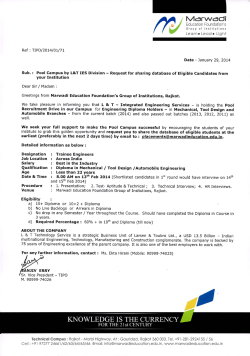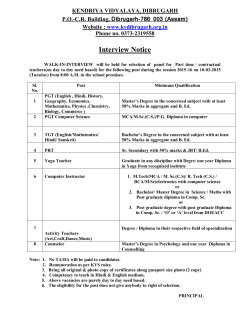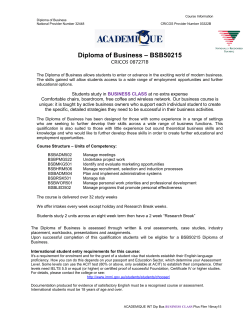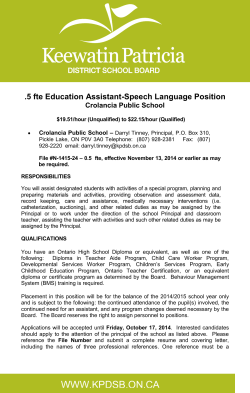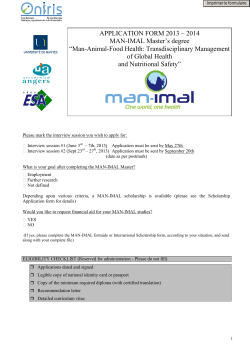
An introduction to functional skills
An introduction to functional skills What do I know about functional skills? What do I need to know? What is my key issue? 1 An introduction to functional skills 2 Objectives Consider the vision and purpose of functional skills Understand the concepts of applied learning, progression and mastery in functional skills Make links to other training and guidance, including the core modules for schools Provide support for further in-school training and professional learning 3 Session 1 Functional skills ‘Functional skills will provide individuals with the essential knowledge, skills and understanding that will enable them to operate confidently, effectively and independently in life and work.’ 14–19 education and skills; implementation plan (DfES, 2005) 1.2 Process, not just content It is essential to think of learners becoming functional with English, mathematics and ICT skills, rather than thinking that there is a vital body of knowledge, known as functional skills. 1.3 The functional skills pilot Started in September 2007 to: – pilot functional skills qualifications – discover the best ways of teaching and learning functional skills – investigate how to develop functional skills for learners in all settings and at all levels. 1.4 The challenge To provide the opportunity for all young people to succeed at a higher level by: – creating clear learning routes that provide the skills and knowledge they need – offering young people the chance to learn in different ways – offering qualifications that are widely understood 1.5 Raising the participation age Progression at the heart of reforms Aim to ensure all young people develop their potential From 2013 all young people required to continue in education or training post 16* This could be in: – full-time education: school and college – work-based learning: apprenticeship – part-time education or training: employment, selfemployment, volunteering 20+ hours a week *Until 17 from 2013 and until their 18th birthday from 2015 1.6 New pathways The qualifications currently available are being brought together into a series of distinct pathways: CONSIDER OPTIONS 14 GCSE Foundation, Higher or Advanced Diploma Further education Foundation or Higher Diploma GCSE / A Level Higher education Foundation Learning Tier CONSIDER OPTIONS 16 Foundation Learning Tier Apprenticeship Employment with training CONSIDER OPTIONS 17 CONSIDER OPTIONS Apprenticeship post-18 18 Employment Employment with training 1.7 Functional skills Functional skills aim to equip young people with the essential skills they need for life, work and study They will be taken by all young people from 2010 They are: – part of the secondary curriculum and the Diploma, Foundation Learning Tier and (from 2010) apprenticeships – being embedded in GCSE English, mathematics and ICT specifications but also assessed separately 1.8 Personal, learning and thinking skills Embedded in the new secondary curriculum, GCSEs and part of generic learning of Diploma Cover six areas: – Independent enquiry – Creative thinking – Reflective learning – Team working – Self management – Effective participation Highly valued by employers and HE 1.9 The Diploma By 2013 an entitlement to all students Combines practical and theoretical achievement Provides access to university as well as to skilled employment and training Helps students understand why certain skills and knowledge are important and lets them apply these to realistic problems and scenarios Existing qualifications such as BTECs, GCSEs and A Levels are available as components Delivered in partnership with other schools, colleges, employers and HEIs 1.10 The Diploma Phase 1 – 2008 Phase 2 – 2009 Phase 3 – 2010 Phase 4 – 2011 Construction Business, Humanities and and the Built Environment Creative and Media Engineering IT Society, Health and Development Administration and Finance Environmental and Land-based Studies Hair and Beauty Studies Public Services Retail Business Sport and Active Leisure Travel and Tourism Social Sciences Languages and International Communication Science Hospitality Manufacturing and Product Design 1.11 Diploma framework Principal learning Generic learning Additional and specialist learning Sector- and subjectrelated skills and knowledge, 50% practical skills used in workplace Functional skills Personal learning and thinking skills (PLTS) Project At least 10 days of work experience Range of additional options endorsed by employers 1.12 Diplomas and functional skills Functional English, mathematics and ICT are embedded in Diploma delivery All three functional skills at Level 1 are required for Foundation Diplomas All three functional skills at Level 2 are required for Higher and Advanced Diplomas 1.13 Functional skills: assessment basics Functional skills are: – stand-alone qualifications in English, mathematics and ICT – available at Entry 1, 2 and 3, and Levels 1 and 2 – use standards that have drawn on the National Curriculum, GCSEs, key skills,and Skills for Life – based on mastery assessment with no grading 1.14 Functional skills: characteristics Functional skills are: – applied skills – transferable – relevant to all contexts – appropriate for all learners 1.15 Session 2 The four factors of progression Complexity: the components within a situation, the steps needed to solve a problem and the accessibility of the task Familiarity: extent to which a learner recognises elements of a problem or situation and is then able to transfer skills from one context to another Technical demand: range of knowledge, skills and techniques Independence: level of autonomy a learner demonstrates when tackling a problem 2.1 Session 3 The three-stage process of learning A successful learner: – builds the full range of functional skills – practises applying those skills in a range of contexts – demonstrates mastery in a range of contexts 3.1 Purposeful activity Purposeful problem-centred activities have both an aim and a reason for tackling the problem Activities need to give a satisfactory answer to the learner’s question ‘Why am I doing this?’ 3.2 Activity Design an information page for parents which gives advice on managing money for students. Support your information page with valid data, advice and appropriate images found using the internet and other sources. Provide some practical examples which demonstrate and explain how interest rates work, using graphs to support your arguments. 3.3 Planning a learning sequence Identify: – the skills that learners will build – the skills that learners will apply – a learning context – what learners already know – the level of demand that is required – which skills are transferable Construct an appropriate learning sequence 3.4 Assessment contexts Work and education Community, citizenship and environment Media and communications Family, home and social issues 3.5 Assessment features Purposeful application of skills in a real-life scenario Task-based or task- and test-based Externally set but may provide for internally contextualised task-based assessment Based on the standards and assessment principles 3.6 Session 4 Good advice Work collaboratively Start small Review and revise Evaluate progress critically Learn from experiences Celebrate success 4.1 Support for functional skills Functional skills support programme: e-learning http://nationalstrategies.standards.dcsf.gov.uk/ DCSF 14-19 www.dcsf.gov.uk/14-19/ 14-19 Reform toolkit www.14-19reforms.co.uk/ QCA www.qca.org.uk/functionalskills LSIS www.lsis.org.uk/14-19 www.excellence.qia.org.uk/159670 Diploma Support Programme www.diploma-support.org 4.2 Teachers’ views Learning has been fun and the students have really engaged with activities because they can see the purpose. It’s developed the skills of the staff and students and there has been a massive improvement in the students’ self-esteem and confidence. Our teachers didn’t want to do it (FSfocused lessons) but they tried it, it worked and even the more difficult classes wanted to do more. Those who achieved Level 2 were really pleased and it encouraged them to go for the C grade. Fantastic opportunity to join up thinking at KS4.
© Copyright 2025


